KANNIEDOOD
We come now to a bend where the road turns quite sharply to the north-west. On the corner is the old water tank shown below.



You are now approximately 20 km from Shingwedzi and from this point the Dipeni Road follows the course of the Shingwedzi River. This stretch of road, which ends at the Shingwedzi Rest Camp, has probably been the most popular game viewing route in the Northern Kruger Park. It is certainly one of our favourite drives. The river is clearly visible throughout most of the route with many, many little loops taking you right onto the edge of the banks. These loops do slow you down, though, and prolong the journey considerably. But, if game viewing is plentiful, this is not a disadvantage!
If there is one animal you can be sure to see in the Shingwedzi area, it is the elephant and it is also quite likely that it will be the first animal you see.


The two photos above were taken at exactly the same place, not far from the water tank. The one with the elephant was in January 2016, the year of the great drought (although the Shingwedzi area had, ironically enough, had some rain) and the other is from January 2017, when the drought had been well and truly broken. (More about this particular elephant later.)
When we first began visiting the Park regularly, I was wary of the bull elephants, always expecting to be charged. However, over the years, we have learnt to recognise the signs of aggression. With the maternal herds you need to be cautious if there are baby elephants there. The smaller the baby, the more protective the cows become.
With the bulls, it depends on whether or not they are in musth (pronounced MUST). During this period (which can be as short as a few weeks to as long as several months) the testosterone levels of the bull increase dramatically. The African Elephant comes into musth from about the age of 25, so a bull in musth will also be impressively large.
There are two signs which indicate the musth.

This is the first sign - a glandular secretion streaming down from the temple.

The second sign. Need I say more! Sometimes they actually spray urine as they walk.
If a bull displaying either of these two signs shows the slightest sign of aggression, then be ready to get out of there! If he is in front of you on or just off the road do NOT try to pass him. Most of the animals in the Park see our vehicles as being rather odd, smelly and noisy animals. A bull in musth will take the roaring of an engine as a challenge and he is MUCH bigger than any car!
Once, in the Letaba area, we drove past a young bull elephant who was hidden in the mopane scrub. He leapt out at us with a scream of rage and, trunk raised, he chased after us with the clear intention of stomping us into the dust! I nearly had a heart attack! I tell you, the thought of being hunted down by one of his larger brothers in musth is nightmare stuff.
The following series of photos was taken down south, but I want to add them in here because they illustrate perfectly how a bull in musth behaves. The photos had to be taken through the windscreen as we had to be ready to reverse at any moment.
Bull elephants normally do not pay attention to traffic. They go about their business - drinking water, taking mud baths or sand showers, plucking up grass to eat or browsing on trees, or giving themselves a good scratch against a convenient tree trunk - all while ignoring you. So when a bull elephant stops and stares at you, you know something is up.

Standing absolutely motionless, excepting for the front leg lifted slightly. Staring at you out of the corner of his eye.

Turning to face you, one front leg slightly lifted, trunk draped across a tusk.

Temporal glandular secretion clearly visible. Trunk raised warningly, may make a mock charge, trumpeting loudly.
Once he has made a mock charge, rather reverse before he comes at you with serious intent! If you are on an incline, the best thing is to roll back quietly. Switching on an engine is regarded as the equivalent of verbal abuse to which he will take huge offence. If we come around a bend, or over a rise, and are suddenly confronted with a large bull, we don’t switch off until we are sure he is in a peaceful mood!
Occasionally, even if they aren’t in musth, some bull elephants will take exception to your presence. This was the case with the elephant on the Shingwedzi. From the size of his tusks he was obviously still quite young and there was no sign of musth. But as he came in our direction, he suddenly stood still, lifted his leg in the typical fashion, and then he charged! What he is like when he is in musth, I do not even want to imagine!

Leg lifted. Stony stare.

Charge!!! This photo taken by brave (or crazy) husband. I was yelling: “Go, go, GO!!!”
Not far from the site above, we came across the one and only lion sighting we have had on this road. Apparently there are plenty of lions in the area, but never when we are there! On this occasion there were two males just off the road. Both were sound asleep, though the one on the right did open his eyes blearily for a few seconds.



A few kilometres further on from where we saw the lions we had one of the most exciting sightings we ever had along this road. This was when we saw a herd of Roan Antelope for the first time. We had been told that there were a few lions in the reeds on the river bed and were given the exact distance to travel from the camp. We parked the Isuzu and waited. To our delight, the herd of Roan appeared over the top of the opposite bank of the river, which is very steep at that point, and gradually came down towards the water. They approached very cautiously and seemed very nervous. It was obvious that they knew the lions were close by. (Not that we got to see any of them!) Unfortunately, it was when I had a very basic camera so the quality of the picture is poor. The photo does, at least, give a very good idea of the terrain at this point. This was in October before the rains, when the river is really just a series of intermittent pools.

The lions were off to the left. The Roan on the upper right did not come down to drink at all. The dark area where the two Roans, front left, are standing is the pool of water.
In January, 2017, after the excellent rains, not far from where we saw the Roan Antelope, this is what the river looked like!

Shingwedzi parking bay!
We arrive now at the damaged wall of the Kanniedood Dam, which was less than 10 km from Shingwedzi Rest Camp.
(Kanniedood is Afrikaans for Cannot Die. The pronunciation of Kannie is not easy for the English tongue. Strictly speaking, the ‘a’ is an ‘ah’ sound but it must not be drawn out. If you say ‘conny’ without rounding your lips you will get it right. Dood will rhyme with ‘poor’ as in tour (not tore!). The second ‘d’ of dood is a ‘t’ sound. So then, CAH-knee-DOOT.)
The wall was partly washed away during the devastating flood of January 2013, as can be seen in the two photos below. Before the flood, you could barely see the wall, it was so overgrown with vegetation, but the flood swept it all away.
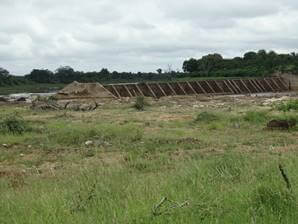
The eastern side of the wall.

Where the western side used to be!

All that is left of the demolished wall. (See centre of photo.)
It was not rebuilt, as the dam at this point has had a negative effect on the ecological environment. It probably also increased the flooding of the area. The camp was inundated causing massive damage. Reports on the flood with aerial photos are freely available on the Internet. Just search for ‘Shingwedzi Flood January 2013 Kruger National Park’. About five years later the wall was completely demolished.
The bird life along the Kanniedood is fantastic during the summer months.

Goliath Heron

Open-billed Stork

Yellow-billed Stork on the opposite bank just before the dam wall.
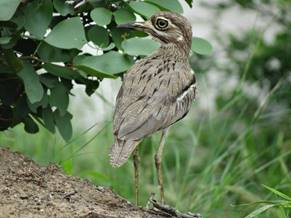
Water Thick-knee
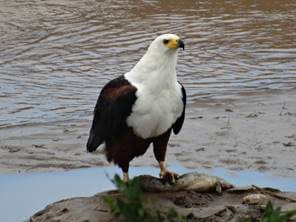
Fish Eagle with breakfast!

Juvenile Fish Eagle
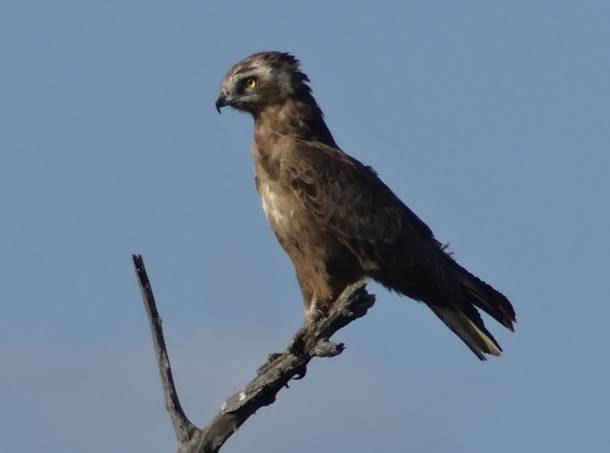
Best Snake Eagle sighting ever!
One of my favourite birds is the Woodland Kingfisher, a summertime visitor to the Park. Its very distinctive call of ‘chip-chirrrr chip-chirrrr’ rings out constantly. (On one occasion we drove past one so close I could have touched it. It practically screamed into my ear and I heard for the first - and only - time that it is actually calling ‘tsip-tsirrrr’) I include a back view so you can appreciate the exquisite colour!
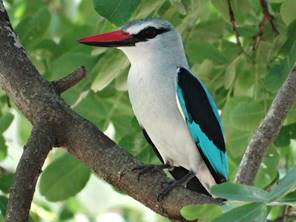
Woodland Kingfisher
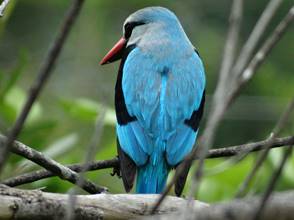
Essence of turquoise!
The kingfishers and the bee-eaters are wonderful subjects to photograph. Like the rollers, they perch for long periods and only fly off when they see their prey. Once they have caught it they immediately return to the same perch or one nearby. The Woodland Kingfisher, though, prefers to sit inside the trees, so can be difficult to locate.
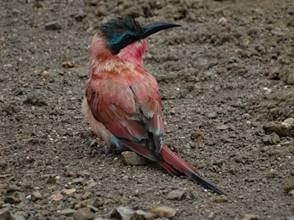
Carmine Bee-eater
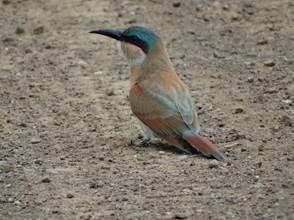
Immature Carmine Bee-eater
The Carmine Bee-eaters are also visitors to the Park. They are actually equatorial birds and stay only for the summer months. When the rains dry up, they migrate northwards back to the equatorial region. The White-fronted Bee-eaters, on the other hand, are residents of the savannah regions, so are to be seen throughout the year. We have had better luck seeing them in the far northern areas of the Park, though.
White-fronted Bee-eaters have very unusual and complex family-based social systems. The breeding pairs are monogamous, but non-breeding members of a family will help with all aspects of breeding - from digging out the nesting holes in cliffs or banks, to incubating and feeding! Fascinating!

White-fronted Bee-eaters
In contrast to the kingfishers and bee-eaters, the hornbills are not as easy to photograph. Not only are they restless, but they feed on the ground where they are constantly on the hop.
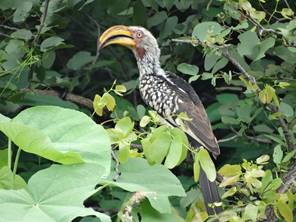
Yellow-billed Hornbill
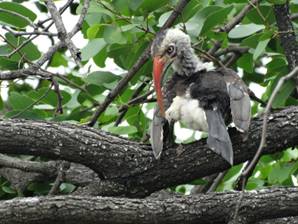
Red-billed Hornbill

Grey Hornbill (male)
This photo of the female Grey Hornbill below (not taken in the Shingwedzi area) shows the difference between the sexes. The female’s bill is finer and the top is yellow, not dark.

There are several resident troops of Chacma Baboons along this route and they have provided great photographic opportunites as well as entertainment.

Baby hanging in there!

Searching for that elusive flea!
One extremely hot afternoon we sat and watched a troop which was resting in the shade. There was one tiny little guy full of the joys of extreme youth. He was all over the place but gave us plenty of opportunites for photos.


Cuteness overload!
Kudu and Waterbuck are also in abundance along the Kanniedood, but the antelope we especially look out for are the Bushbuck and Nyala.
The Bushbuck especially often lie quietly under overhanging bushes and you have to peer intently into the undergrowth to see them. They are also very solitary. The only time a Bushbuck ewe is accompanied, it is by her lamb.

Bushbuck ram

Bushbuck ewe
The Nyala, on the other hand, are sociable and are seldom alone. The males wander about in groups of two or three (we did once see a group of eight!), as do the females. We have seen a single bull with several females plus lambs, and we have also seen a family group consisting only of mom, dad and baby. Just to be clear, the female Nyalas are referred to as ewes, but the males as bulls - which strange anomaly is probably due to the fact that the male is too large to be referred to as a ram, while the female is too small to be called a cow! A mature male is consideraly larger than a mature female. Of all the antelope species the difference between the sexes with regard to colour is also the greatest.

Nyala bull

Nyala ewe
One of the most elusive of the small antelope is the Sharpe’s Grysbok.
The pronunciation is a bit tricky because of the Afrikaans ‘g’. Once again, as in the previous chapter on Grootvlei, we point out that the ‘g’ is the same sound as in the German ‘ach’ or the Scotch ‘och’. Grys then is pronounced CH-RACE. The literal meaning of ‘grys’ is grey or grizzled. The pronunciation of ‘bok’ is BAWK. It means buck. It is quite acceptable to say CHRACE-buck if you happen to feel silly saying ‘bawk’!
This exquisite and tiny buck is very shy and timid. It is only to be found in the northern parts of the Park, although we did once see one between Orpen and Satara. Most of our sightings have been along the Mphongolo River (more of that area later), but our best sighting was here along the Kanniedood. It was right at the side of the road as we came around a bend, so we did not have time to approach cautiously. We travelled on and then, when it was out of sight, we turned round and approached slowly, hoping it would not have scooted off. To our absolute delight, our strategy was successful and it was still there peacefully grazing under the bush. Apart from giving us the occasional glance, it carried on with its business and we have a host of excellent shots.
What a stroke of luck!



A glance at the photo will show how it got its name. While it is not grey, the liberal sprinkling of white hair does give it a very grizzled appearance!
It only weighs about 10 kg (22 lbs) and is about 50 cm (20”) high at the shoulder, so is not much bigger than a Cocker Spaniel or a Beagle! There is no difference as to size between the sexes. They are solitary, and are only seen together when breeding. However, it is thought that they do share a territory with a mate in a monogamous relationship, but this has not been proven (as far as I know). The little ewe bears a single lamb weighing all of 1 kg (just over 2 lbs)! (How I would love to see one!)

Coming...

Going...

Same Mom and baby from the left...
The Kanniedood Dam area is also frequented by many elephant herds. Some of them come from the other side of the river. They come down the banks, slake their thirst, have their showers and then they’re off again.
But it is in the loops, which are such a feature of this route, that you stand a good chance of suddenly finding yourself in the midst of a herd or being confronted by an unimpressed mom. And even though the cows are nowhere near the size of the bulls, they are still much bigger than your vehicle!
For the most part we have not had any bad experiences with the maternal herds here on Kanniedood, but this mama did get us to reverse!

We are now within metres of the camp’s back gate. To the right is the turn-off to the S135 which crosses the Shingwedzi via a low water bridge. When the rains have been heavy then this route is closed for obvious reasons, as the photos below clearly illustrate!


However, when the road is open, the low-water bridge provides an interesting perspective. The bridge acts as a weir so you will be almost certain to see hippo.

Upstream with the camp on the left.

Downstream. The river channel is on the right.
And now for the final sighting on the Kanniedood Road. This was taken on a late afternoon drive from the camp to the Kanniedood Dam wall. This beautiful Bushbuck ewe was just outside the gate. We caught her by surprise, and as I had my camera ready, I was fortunate enough to get this amazing shot. A split second later she turned and dashed for the safety of the undergrowth.

Just a word of warning for enthusiastic newcomers to this road. If you set out at dawn along this road the chances are you will see nothing - and I mean zippo! We once left Shingwedzi before sunrise with Letaba as our destination. We were deeply disappointed. Along the entire S50 the only animal we saw was a single Tsessebe as we neared Nshawu.
Mid-morning to late afternoon is definitely a better time!
Another word of caution I would add. With the destruction of the Kanniedood dam wall, the game viewing patterns are possibly going to change. It will be interesting to see whether this route remains such a prolific source of gorgeous photos!